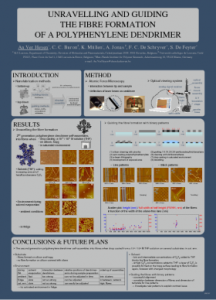Guided fibre formation of a polyphenylene dendrimer
Poster presentation at Leuven Nano-Conference – LNC’07, June 5-6, 2007, Leuven, Belgium
(click on the image to see the poster in large scale)
- Abstract book (click here to view the abstract book)
- Leuven-MRC (click here to go to the `Materials Research Centre’ website)
- INPAC (click here to go to the `Institute for Nanoscale Physics and Chemistry’ website)
Abstract:
The processing and the manipulation of complex architectures on the nano scale is one of the key issues towards a technology based on smart materials. In order to design efficient functional devices it is important to control the structure of organic materials down to the nanometre scale.
We investigate the self-assembly of a second generation dendrimer [1] on a surface into fibres by examining the conditions of sample preparation and the structures formed. To investigate the influence of the nature of the molecule on fibre formation, a variety of similar dendrimers (different structures and functionalities) were drop cast on a substrate and studied with atomic force microscopy (AFM). Several other effects were studied: the substrate, the solvent, the environment, also the solvent drying was imaged optically durig sample preparation.
The fibres probably form due to the interpenetration of branches of interacting dendrimers. The driving force for the formation of the fibres is attributed to the pi-pi and van der Waals interactions among dendrimer branches.
There are different ways to achieve control on self-assembly, but most often they rely on some degree of programming of the elements to be assembled. The assembly code may be stored in the chemical structure of the elements or in the environment of the elements. Self-assembly of individual molecules can lead to formation of higher ordered structures such as fibres. In nature this phenomenon is abundantly present: formation of DNA double helix, collagen…
We used PDMS-stamps and molds, magnetic fields and pre-patterned substrates to guide the fibre formation. The pre-patterned substrates gave best results and are therefore best suited to obtain guided self-assembly of the second generation polyphenylene dendrimer into nano fibres.
[1] D. Liu, S. De Feyter, M. Cotlet, U.-M. Wiesler, T. Weil, A. Herrmann, K. Müllen and F. C. De Schryver, Macromolecules, 2003, 36, 22, 8489-8498
